NWRC Research Areas: Rodents

Our scientists are developing methods and strategies to manage rodent impacts to agriculture, natural resources, and human health and safety.
Large numbers of invasive (nonnative) animals have become established in the continental United States, its Territories, and nearby countries and islands. These include fish (grass carp, tilapia, walking catfish), reptiles and amphibians (brown treesnake, cane toad, Caribbean tree frog), birds (myna, monk parakeet, mute swan, starling, pigeon) and mammals (feral livestock, dogs, and cats; mongooses; rats; and nutria). Invasive vertebrate species cause substantial damage to crops and livestock, property, and natural resources (including threatened and endangered species, biodiversity, and ecosystem health), and pose a disease hazard to humans and livestock.
There is a need to develop methods and strategies for invasive vertebrate species so that scientists can (1) assess the risks of an introduction occurring, (2) detect and monitor populations, (3) manage or eliminate populations, (4) mitigate the adverse effects where invasive species cannot be effectively controlled, and (5) prevent future introductions. Methods developed must be effective, economical and environmentally benign. In most cases, an integrated strategy, using several methods (cultural, physical, chemical, etc.), will be required to effectively manage or eradicate the invasive vertebrate population.
Effective, target-specific delivery systems for control agents (toxicants, fertility control, vaccines) are an important, if not critical, need for successful strategies. In some cases, basic research on the biology and ecology of the species will be needed. Species of major concern for NWRC and all of Wildlife Services include starlings, pigeons, feral swine, nutria, foxes, cats, and rats.The research examined in this new project will focus on invasive rodent species because of the significant threat they pose and because they can serve as a model for other vertebrates.
Project Goal and Objectives
Development of Methods to Control Rodent Populations and Damage with an Emphasis on Invasive House Mice and Native Voles
Goal: Develop methods to reduce invasive and native rodent damage with both lethal and nonlethal approaches.
Objectives:
Develop and test new potential rodenticides to replace ineffective rodenticides and products no longer available.
Develop and test new delivery systems for chemical delivery to rodents.
Develop and test barrier systems for rodent and rabbit damage reduction.
Develop and test repellents for rodent and rabbit damage reduction.
Develop and test fertility control materials for rodent and rabbit population management.
Review current and potential strategies and approaches to rodent and rabbit damage reduction.
Provide service assistance to stakeholders through consultations.
Publications
Videos
Contact Us
Rodents Research
Aaron Shiels, Project Leader
Email: aaron.b.shiels@usda.gov
Phone: 970-266-6324
4101 LaPorte Avenue
Fort Collins, CO 80521

